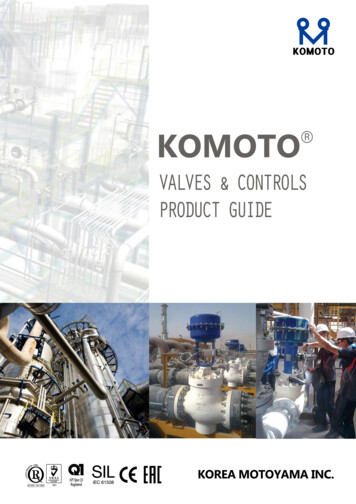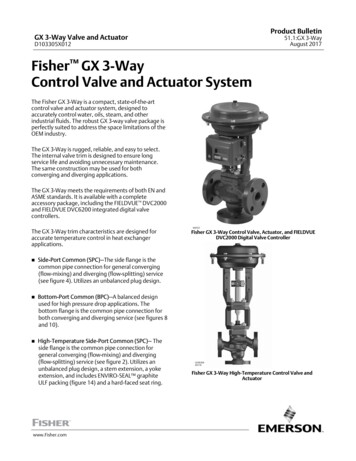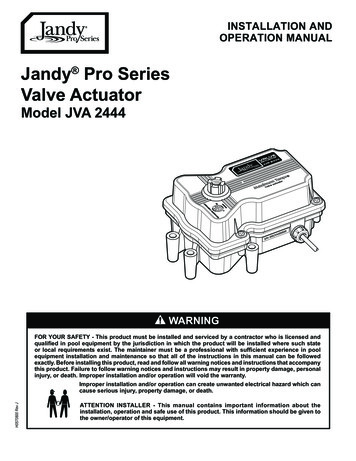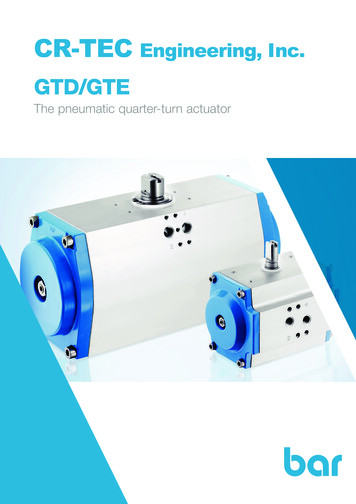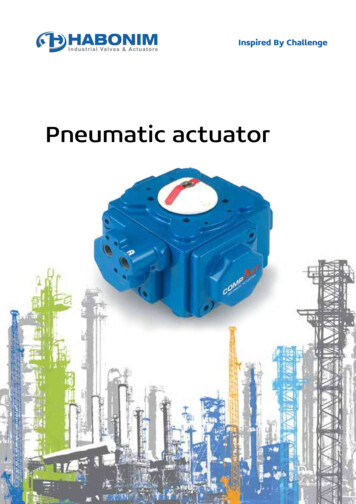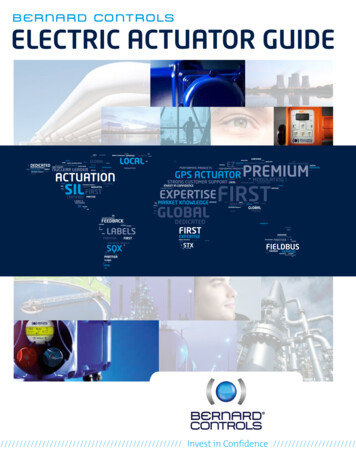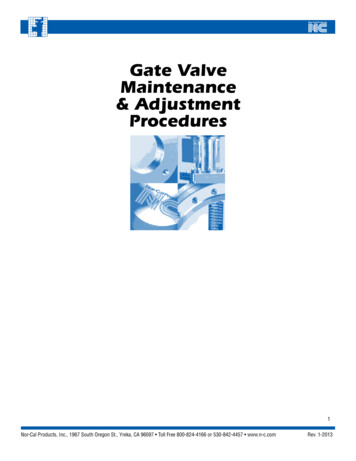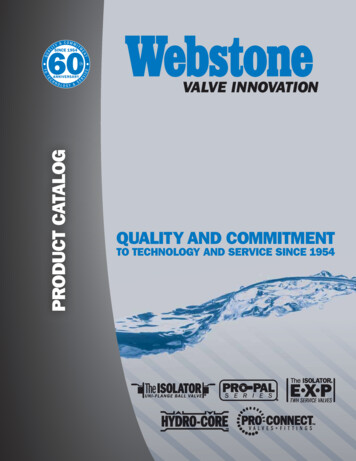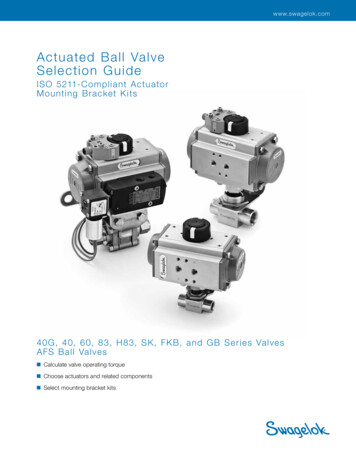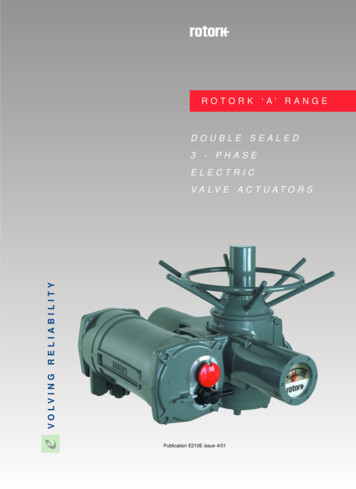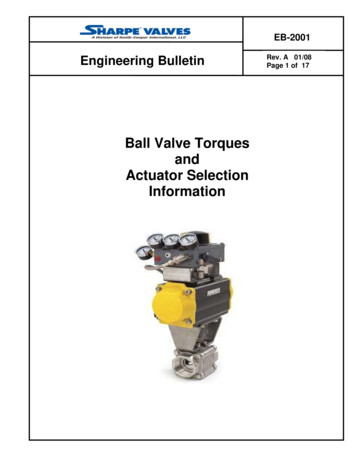
Transcription
EB-2001Engineering BulletinBall Valve TorquesandActuator SelectionInformationRev. A 01/08Page 1 of 17
EB-2001Page 2 of 17General Information:This bulletin contains basic information ondetermining the actual ball valve torques tobe used for actuator selection.Thefollowing pages contain valve torque tablesfor the various Sharpe Valve models, alongwith Media and Service Factors which mustbe considered.Ball Valve Torques:The torque values listed in the followingtables are breakaway torques from theclosed position. Breakaway torques aredetermined by measured after the valvehas been in the closed position underpressure for a set time period, and are thehighest torques expected.Seat Materials:The seat materials used in a valve willsignificantly influence operating torque.Softer, lower-friction seats (such as TFE orTFMTM will be lower in torque than theharder, higher friction factor materials suchas Delrin or PEEK. Different tables havebeen provided where seat materialssignificantly affect operating torqueService Application:How the valve will be operated, and howfrequently also affect actuator selection andtorque. Infrequent operation will requirehigher torque values than for valves inmodulating services, for example. Servicefactors are provided in the tables at the endof this bulletin.Line Media:What is flowing through the valve can havethe most significant effect on valveoperating torques. Fine solids, slurries, orvery viscous fluids can have great effect,not only on torque, but also on valveservice life.Media factors are alsoprovided in the tables at the end of thisbulletin.Torque Reduction Factor:When being used with rack & pinionpneumatic spring return actuators, a 0.70multiplier may be applied to the ball valvetorque.The valve torques are breakaway valuesfrom the closed position, and spring returnactuators are selected on the minimum ofeither the spring ending or air endingtorques. A “SR” actuator selected on thisbasis would probably be over-sized, sincethe valve torque is at maximum, andactuator torque is at minimum.The 0.70 factor reflects the maximum valvetorque expected other than breakaway, andconsiders that the maximum output torqueof the spring return rack and pinionactuator is at the start of the stroke.This would not apply to a scotch yoke orcrank arm actuator, because the torquecurve for these designs dips in the center,and may fall below the valve running torqueif not sized based on full break torque forthe valve.The 0.70 torque factor does not apply todouble acting rack & pinion actuatorsbecause the output torque is constant overthe full stroke.Thus, double actingactuators are sized based on maximumvalve torque and maximum actuator torque.
EB-2001Page 3 of 17Sharpe 12 and 13 Series Dir-Act (lbf-in)TFM and NOVA seatsSeries 133¼, /8, ½”¾”1”1 ¼”1 ½”2”Series 12Nova/TFM350¼, /8, ½”¾”1001”1401 ¼”2001 50SHARPE 66, 86 and 88 Series (lbf-in)Torque Values at Maximum RatingTeflon SeatsRTFE SeatsCavity 5300450100016003000
EB-2001, Rev. APage 4 of 17SERIES 84/99 TORQUESPTFE (T) ORQUE 0100100200300400500600PRESSURE (PSID)70080090010001100
BB-2001, Rev. APage 5 of 17SERIES 84/99 TORQUESTFM 2"TORQUE 00600700800900PRESSURE (PSID)1000 1100 1200 1300 1400 1500 1600
EB-2001, Rev. APage 6 of 17SERIES 84/99 TORQUESRTFE ("R") 2"2-1/2"10009008007006002"Torque /4-1/250403020100100200300400500600700800900 1000 1100 1200 1300 1400 1500 1600Pressure (PSID)
EB-2001, Rev. APage 7 of 17SERIES 84/99 TORQUESNOVA (N) 3"Torque 00600700800900Pressure (PSID)1000 1100 1200 1300 1400 1500 1600
EB-2001, Rev. APage 8 of 17SERIES 84/99 TORQUESUHMWPE 900800700TORQUE 0PRESSURE (PSID)800900100011001200
EB-2001, Rev. APage 9 of 17SERIES 84/99 TORQUESDELRIN SEATS10009008007006002"5004001-1/2"3001-1/4"Torque 681012141618Pressure (PSID) x 100202224262830
EB-2001, Rev. APage 10 of 17SERIES 84/99 TORQUESPEEK 3"10009008007002"Torque 10090807060504030201002468101214161820Pressure (PSID) x 100222426283032
EB-2001 Rev. Apage 11 of 17SERIES 84/99 TORQUESRTFE Torque 0600700800900 1000 1100 1200 1300 1400 1500 1600Pressure (PSID)
EB-2001 Rev. Apage 12 of 17SERIES 84/99 TORQUESPCTFE (Kel-F) 02"Torque 00700800900 1000 1100 1200 1300 1400 1500 1600Pressure (PSID)
EB-2001Page 13 of 17SERIES 50/FS50 TORQUESCLASS 150/300RTFE & NOVA ue 50300350400450Pressure (PSID)500550600650700750800
EB-2001 Rev. APage 14 of 17SERIES 50 TORQUESCL 600 RTFE / NOVA 9008007002"600Torque 03020100100200300400500600700800900Pressure (PSID)1000110012001300140015001600
EB-2001, Rev.APage 15 of 17SERIES 54 TORQUE CHARTRTFE AND NOVA 9008007004"Torque 605040302010020406080100120140160180Pressure (PSID)200220240260280300320
EB-2001, Rev. APage 16 of 17SER. 60 TorquesCL2500 Delrin/PEEK 0800700TORQUE 504030201005001000150020002500300035004000PRESSURE (PSID)450050005500600065007000
EB-2001Page 17 of 17Series 99 Torques (lbf-in)Use values in tables for Series 84 valves, except select one size larger. For example, to findthe torque for a 1-1/2” Series 99 valve, use the torque value listed for a 2” Series 84 valve.Media and Service Factors:Media FactorsMultiplierService FactorsMultiplierClean, particle free, nonlubricating (water, alcohol, etc.)Clean, particle free, lubricating(oils, hydraulic fluid, etcSlurries or heavily corroded andcontaminated systemsGas or saturated steam, cleanand wetGas or superheated steam, cleanand dryGas, dirty unfiltered e.g. naturalgas, Chlorine1.00Simple On and Off Operations1.000.80Throttling1.202.00Positioner Control1.501.00Once per day Operations1.201.30Once every two days or a "PlantCritical" Operation1.50Design FactorsMultiplierSpring Return - R &P ActuatorAll Other Actuators0.701.001.50Torque Determination Example:3” Series 84 w/Nova Seats, 600 PSIG, Nitrogen Gas, On-Off Service, Fail Closed ActuatorDesign FactorBasic Torque1393X0.70Media FactorX1.30Service FactorX1.00Sizing Torque 1449 lbf-in
the valve torque is at maximum, and actuator torque is at minimum. The 0.70 factor reflects the maximum valve torque expected other than breakaway, and considers that the maximum output torque of the spring return rack and pinion actuator is at the start of the stroke. This would not apply to a scotch yoke or crank arm actuator, because the torque
